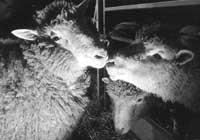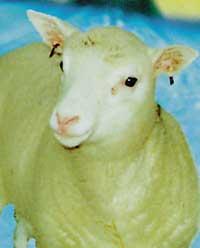A small step..

British writer Aldous Huxley described clonic beings in 1932 in his book Bai mundu berria. Fiction, however, approached reality in a new step II. During the World War. On the occasion of his desire to be an example of race and exemplarity, the orders of Hitler were carried out many attempts under the direction of Josef Mengele, who we knew as the Angel of Death; since then, for many citizens, genetic manipulation has been linked to these events of Auschwich forever. In addition, fiction has ensured the survival of this dark myth through several novels and films, as is undoubtedly the case of the children of Brazil.
It is no wonder, therefore, the controversy that has provoked nothing more to open the news of Dolly. The dream of reason causes monsters and ignorance, or half-truths, fear. As it has been possible to clone beings of high level, why not, as it is usually said in the circus, more difficult even the lords, clone to man?
The debate does not focus on the viability of the technique used by the researchers of the Roslin Institute of Scotland, nor on the problems that can be the manipulation of animal genetic information; the problem that has provoked intense sessions in newspapers, radios, television and colloquial gatherings has been limited to the potential use of this technique: Will the human being come to manipulate his own species in a desired way? Once the road is opened, who will put the barriers to the sea?
After Dolly, what?

Ian Wilmut has shown himself again and again against the human cloning. “Technically analyzed, it would not be anything difficult, of course, researchers should go beyond the steps taken to get Dolly if at some point they wanted to transplant the genetic code of human beings, but after having heard those words. As is known, there is always a risk that someone will do something in science, as in other areas of life. In Western States, in most cases explicitly and otherwise implicitly, it is totally forbidden to be human as possible. The problem is not the viability of the technique we have used; we should analyze the ethical content of that possible use and, in my opinion, the researchers who work with me, that would be an injustice. Ethically it is not possible to accept such experiments, it is contrary to human law.” These statements were made in all news agencies; Ian Wilmut, head of the Roslin Institute research team, spoke to reassure people.
However, the environment was not entirely to manipulate the genetic information of them. From the very moment the Genome Project was launched, this debate on bioethics was opened to the public. According to Xabier Etxeberria, director of the Chair of Ethics at the University of Deusto, “everything that can be done doesn’t have to be done. Starting from this base, I believe that in the future there will be no need to raise the possibility of cloning with the human being. (...) Because research cannot cause more harm than benefits.” In his statements to the Basque Newspaper, Xabier Etxeberria highlighted the need to create an ontological code that regulates and controls this type of research.

We have also heard that cloning with animals and humans should be distinguished. It will seem obvious to you what has been said, reader, but after reading what has been read in recent months we have dared to say again. Science is at the same time the only one responsible for all our evils and the only solution. Science itself will save us from tragedy or from the flames of hell to help us take away. There is no way, there is no one who has put science and technology in place; we have not heard almost anywhere that the development of science is not in itself good or bad, but accidental. Given the timid information we have received about Dolly, we have lacked the umbrella of prudence.
Can it be beneficial?
Without a doubt. The genetic code of these animals can explain the mysteries of life. In our genes, the characteristics of life are codified. Knowing them and, where necessary, correcting them, would allow us to overcome many obstacles. For example, a complete pathway of recovery of many diseases or new possibilities of organ transplantation. Currently in medicine several animals are used as a bioreactor, to which they are incorporated a foreign gene to produce anti-disease substances. It is an example, of course.
All said is the sudden launch with the cloning of superior beings in the head. If we analyze the genetic manipulation of plants, the field of benefits extends more: the production of substances against certain diseases, the abundance of foods that resist pests, etc., and much more. These experiments are already being carried out and in some cases the success will be vital for millions of citizens. There is the rival of the coin.
Can it be harmful?
Without a doubt. Unfortunately, at the moment unilateral coins have not been found, so it is inevitable that all coins have their opponent and patch.

Genetic manipulation can accelerate the loss of biodiversity and, as we know, it is already a rather serious problem to deepen more. The following example serves to understand what we mean. Suppose we have the possibility of massively producing a variety of plants capable of dealing with a certain type of pests; logically, the rest of varieties of the plant is discarded little by little, because we have a healthier, more productive plant and, in short, better. Without remedy, the plant will lose its genetic treasure, it will only be a matter of time. What's more, if the mechanism that causes this epidemic detects and overcomes the protection systems of this variety, the plant would lose, in addition to the genetic treasure, all its chances of survival. In a few years, months or days, we should remove one of the existing plant species in the world, another.
What Heidegger said today seems prophetic: “The ability to manipulate one’s own life will be in the future more dangerous than new technologies capable of causing death.”
Lee Silver Princenton, Professor of Biology at Princenton University “It’s amazing. In essence this means that we have already overcome all limits; it means that science fiction has become a reality. They said it was never going to be done and it has already been achieved before the year 2000.” |
J.L. of the Serna Scientific Journalist “(...) After a few years, cloning animals is not, as today, an exception that excites us, but a common practice, because the benefits that it can report are so great! Then, after having properly tested the usefulness of all these techniques, someone has the temptation to clone also to human beings. Undoubtedly, the laws will prohibit this path, but it will be useless. Someone will take the steps to make Mengele’s dream come true and society can do nothing.” |
Juan Ramón Lacadena, Professor of Genetics at the Complutense University of Madrid “Bioethics, understood as a rebellion among interdisciplinary experts, is increasingly important in the scientific community. According to Severo Ochoa, the development of science cannot stop (...) the path Dolly has taught us is the result of that development. Hence we should not deduce that human beings will also come to clone. It is not necessarily derived from that achievement.” |
Joseph Rotblat, Nobel Peace Prize winner “The development of science can totally condition the future of the human species. My main concern with these facts is that, to the extent that science advances, we will have more and more access to resources that can cause mass destruction; it will be easier and easier to destroy our world by disappointment or neglect. Genetic engineering can facilitate access to this competition to anyone.” |
Joaquín Araujo Divulgative and ecological science “We have now discovered cloning, but it’s the last step of something that has been taking shape for a long time. Our world is already clonic; look at our way of life, our culture, our way of being. It all depends on a canon and we are encouraging behaviors that will be impossible in the short term. The homogenization of the cattle hut, therefore, seems to me an anecdote if we compare it with the model of clonic life that involves asphalt, cement, economic globalization or the media. All this with the ultimate goal of ending inequality (...) Bertrand Rusell pointed out that scientific knowledge facilitates the way to destroy everything.” |
Researcher Ian Wilmut, co-founder of the Roslin Institute and Dolly “It seems to me very contemptible that man wants to clone, and I see no need. In any case, I have loved the controversy that arose around our research. All of this has served to make our work known to governments and citizens. Some accuse us of not having carried out any ethical study before delving into this line of work. When did we have to do that study and, even more, if we do it? Scientists have been working on it for about 40 years, but so far it has not been considered. At first it was also commented that this concern, that is, we would come to find techniques of human cloning, but they considered us crazy.» |





